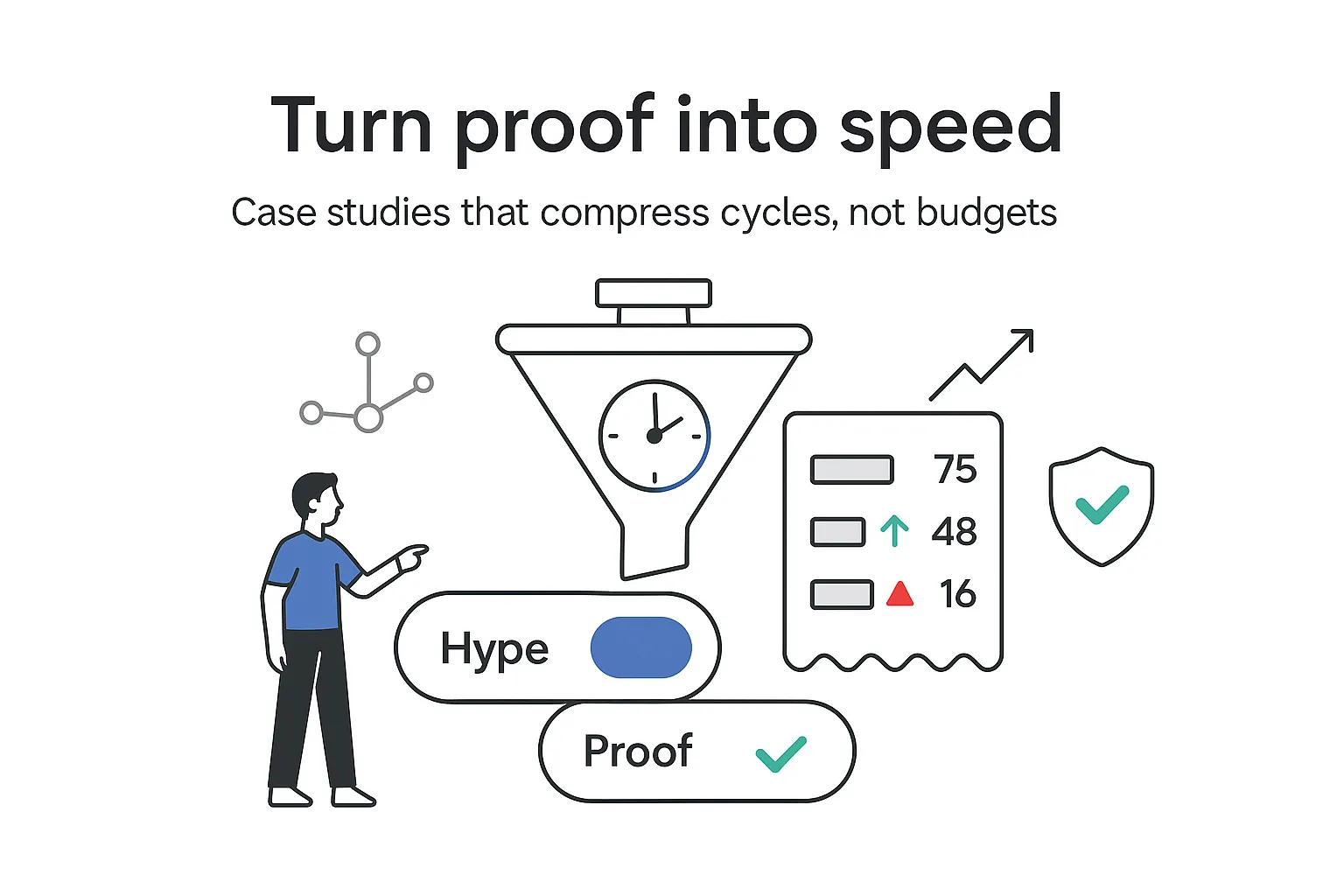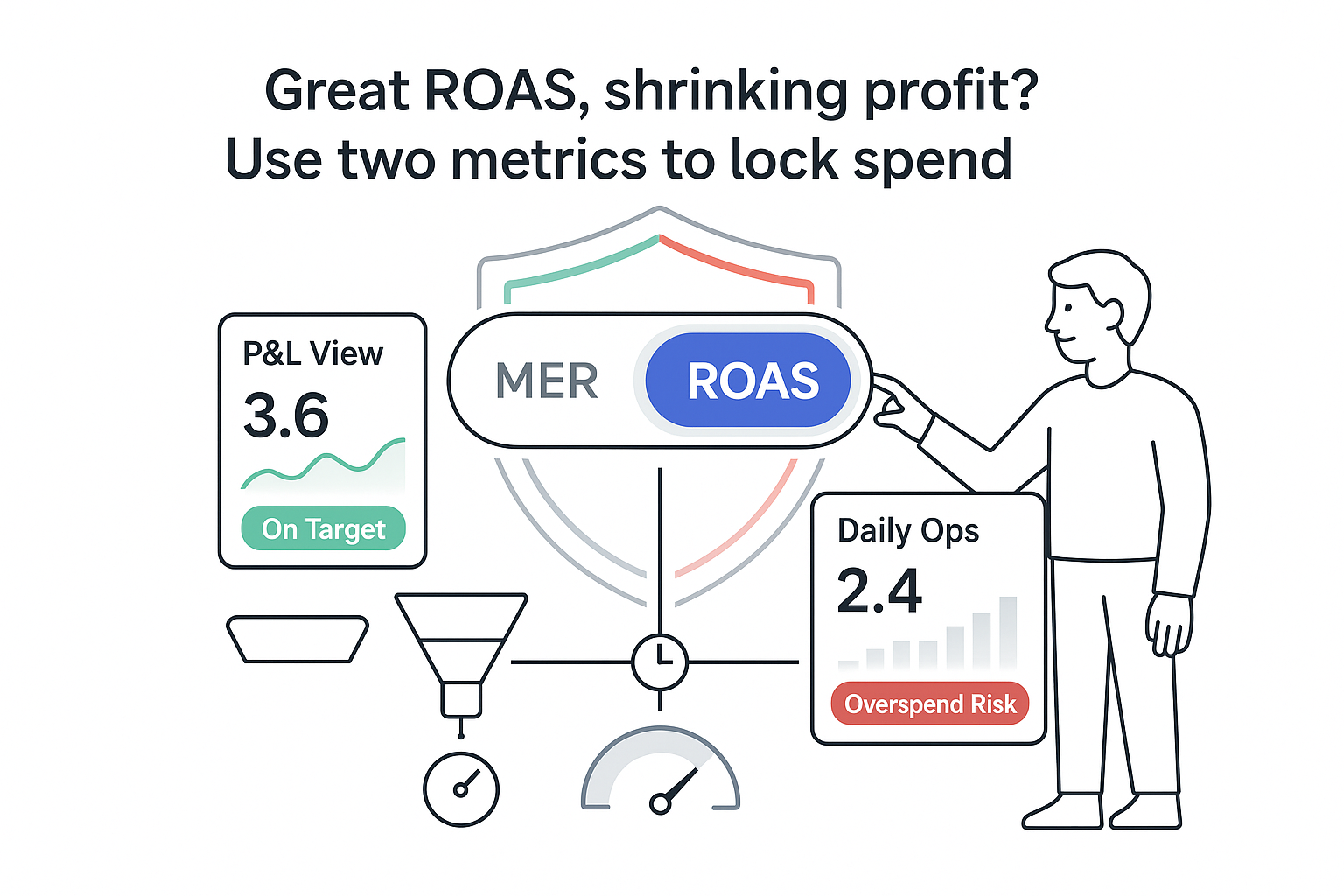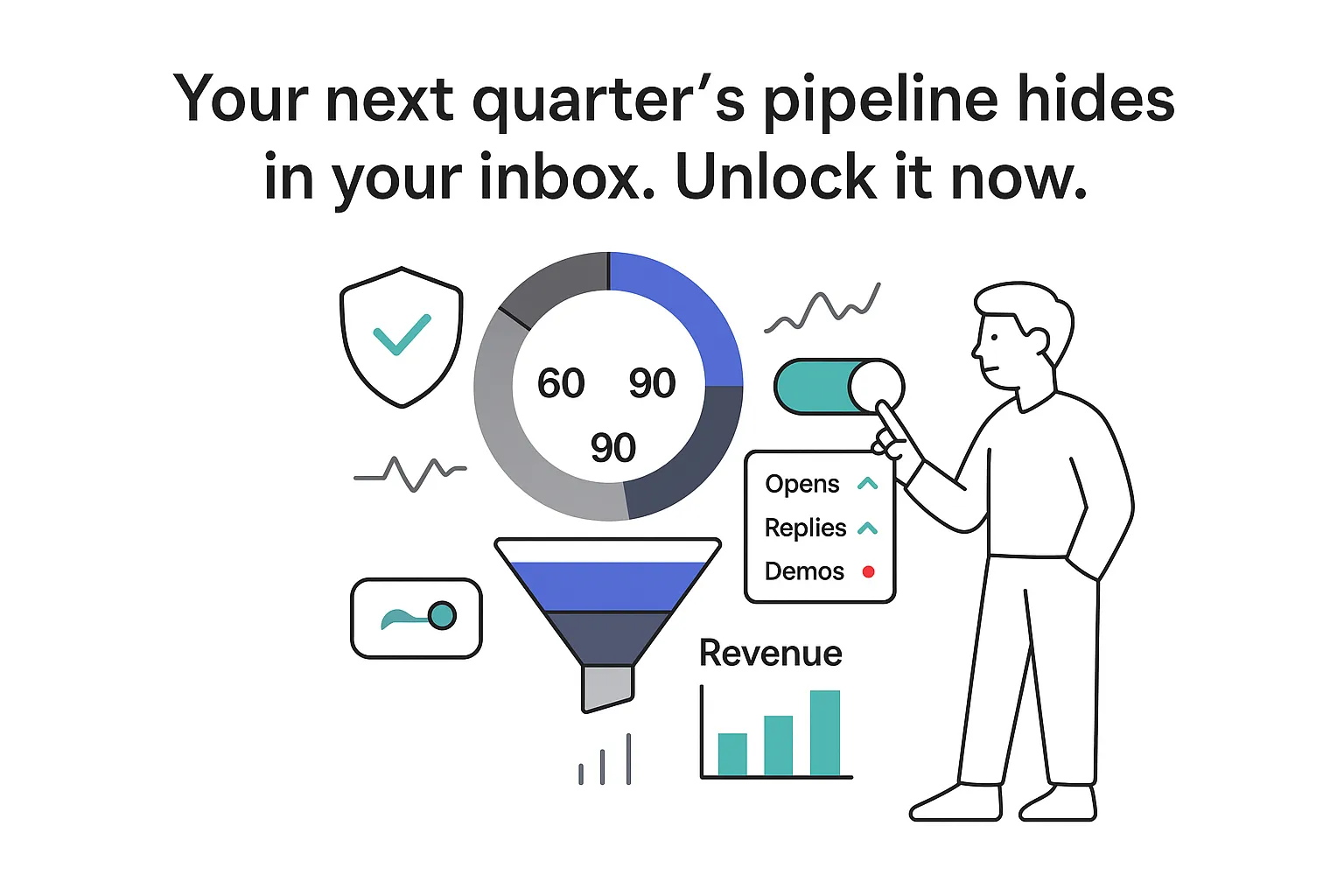I see the same thing across B2B: buyers will not take a call without proof. They want receipts, not rhetoric. Numbers-first case studies cut through noise, shorten cycles, and give you something credible to share with every stakeholder. In this guide, I share practical examples, a template, and a repeatable process to build the kind of proof that helps you hit next quarter's target without inflating ad spend.
B2B case study examples
I use composite, anonymized examples to show what strong outcomes look like and how to present them. They highlight revenue impact, sales velocity, and payback, and each one maps to a common service model so you can picture it in your world.
IT services, mid-market manufacturer
- Client type: 300-person manufacturer, Midwest
- Problem: Legacy ERP upgrades stalled; support tickets lagged; ops team blocked pipeline growth
- Solution: Managed IT with a staged ERP upgrade, SSO rollout, and ticket automation
- Outcomes: 3.2 million dollars in influenced pipeline within 90 days; sales cycles 42 percent faster for ops-led deals; ACV up 18 percent from expansion; payback in 4.5 months; CAC:LTV 1:9 based on service margins
- Industry tag: Manufacturing IT. Deal cycle: 45 to 75 days
Consulting, revenue operations for B2B SaaS
- Client type: Series B SaaS, 80-person GTM org
- Problem: Leaky handoffs, bloated tech stack, unclear attribution
- Solution: RevOps audit, lead scoring, lifecycle rebuild in HubSpot and Salesforce, and enablement
- Outcomes: 28 percent lift in SQL-to-win rate; 24-day reduction in median cycle length; 1.4 million dollars in added pipeline in quarter one; payback in 3 months across project and retainer; ACV grew 12 percent due to cleaner expansion motions
- Industry tag: SaaS RevOps. Deal cycle: 30 to 60 days
SaaS implementation partner, security platform rollout
- Client type: Healthcare network, 12 clinics
- Problem: Security audit risks and compliance gaps blocked new partnerships
- Solution: SOC 2-minded rollout of a security platform, SSO, MDM, staff training, and audit prep
- Outcomes: Passed audit on first attempt; unlocked two enterprise contracts worth 900 thousand dollars combined ACV; pipeline influenced at 2.3 million dollars; payback in 5 months; CAC:LTV 1:11 for services plus follow-on support
- Industry tag: Healthcare IT security. Deal cycle: 60 to 120 days
Marketing agency, B2B demand gen for professional services
- Client type: Consulting firm selling six-figure projects
- Problem: Heavy reliance on outbound and referrals; thin organic footprint
- Solution: ICP research, proof-led content engine, SEO hub pages, paid social for remarketing, and a tight sales content kit
- Outcomes: 118 percent growth in qualified inbound pipeline within 6 months; 31 percent cut in blended CAC; 7.8 percent lift in average deal size due to pricing confidence from proof assets; payback in 4 months
- Industry tag: Professional services marketing. Deal cycle: 60 to 150 days
Logistics provider, managed freight analytics
- Client type: Regional distributor with fragmented carriers
- Problem: Freight costs spiked with no clear visibility
- Solution: Analytics rollout, contract rebids, and rule-based routing
- Outcomes: 14 percent reduction in freight cost per shipment; 19 days faster AP cycle due to cleaner data; 1.1 million dollars in annualized savings; pipeline influenced at 1.7 million dollars from referrals and cross-sell; payback in 2.5 months
- Industry tag: Logistics and supply chain. Deal cycle: 45 to 90 days
Professional services, compliance advisory for fintech
- Client type: Payments startup entering regulated markets
- Problem: Delays due to compliance questions from enterprise buyers
- Solution: Build a complete compliance program, evidence library, and security content pack for sales
- Outcomes: 22 percent increase in enterprise win rate; 33-day shorter security review on average; 2 million dollars in closed-won in one quarter tied to the program; payback in 3 months; CAC:LTV 1:13 when factoring downstream support work
- Industry tag: Fintech compliance. Deal cycle: 90 to 180 days
I keep a simple pattern across these: name the client, the blocker, the intervention, and the numbers that matter. Buyers want to see pipeline, ACV, CAC:LTV, cycle time, win rate, and payback. Give them that.
Image ideas: before/after metric cards, small timeline chips showing cycle time dropping, one compact chart of pipeline by month.
Case study template
A solid case study template saves time and keeps the story consistent across your site, proposals, and outbound. I keep two versions: a one-pager for early-stage touches and a long-form version for researchers and buying committees. If you want ready-to-use layouts, explore these case study templates.
Suggested sections for both versions
- Headline that includes a key metric and the client type
- Client snapshot with size, industry, and ICP fit
- Buying committee summary with top roles and key concerns
- Challenge and constraints, stated in plain language
- Approach and solution architecture, including process and tech
- Implementation timeline with milestones, owners, and approvals
- Results and metrics, showing leading and lagging indicators
- Objections handled: what almost killed the deal and how it was solved
- Testimonial with name and title, plus permission status
- Visuals, charts, screenshots, and redacted dashboards
- Compliance and security notes when relevant
- Related resources for readers who want more depth
For the one-pager, keep it tight
- 300 to 400 words
- Two to three metrics tied to revenue and speed
- One short quote that echoes the outcome
- A single visual
For the long-form version, go deeper
- 800 to 1,200 words
- A short story arc: problem → plan → proof
- More technical detail for evaluators
- A compact appendix with stack details and a glossary
B2B-specific fields pay off. Capture the ICP segment, company stage, contract terms that shaped the work, and procurement factors such as security reviews or legal riders. This intel makes your case studies feel real to buyers who live those details every week.
Image ideas: template preview with callouts, small annotations over each section that show the goal of that part.

How to write a case study
Here is the simple process I reuse without getting stuck in endless edits.
1) Choose a case study template
Pick one format from your shared library and stick to it. Set file naming rules and version history so your team avoids duplicate drafts.
2) Interview your client
Schedule one short call with the project owner and one with the economic buyer if possible. Ask for baseline numbers, constraints, and target outcomes set at kickoff. Capture quotes that feel human, not scripted. Confirm approvals for names, logos, and any screenshots. If meetings slip, send an async form with focused questions and request access to a shared data room. For a real example of interview prompts, Biddyco asked him the following questions.
3) Describe the situation
Write two or three lines that name the client profile, the blocker, and the stakes. Include baseline metrics with clear time frames. Mention constraints such as budget, team size, or compliance rules. Keep it direct.
4) Identify the solution
Share the approach and the solution architecture. List key methods, platforms, and handoffs. Add the timeline and who did what. Name trade-offs and explain why they worked.
5) Present the results
Lead with the numbers. Show impact on pipeline, win rate, ACV, cycle time, costs, and payback. Add a simple chart. Include one short quote that echoes the outcome. Note any second-order wins such as reductions in churn or improved onboarding speed. For visual inspiration that reads fast, see 10+ Case Study Infographic Templates That Convert.
To cut back-and-forth edits, align on a clean approval flow:
- Draft created by the content owner
- Data validated by an analyst
- Client quote approved by the client contact
- Final review by your brand owner, legal if needed, and the account lead
One more sanity check helps. Ask a rep who did not work on the account to read the draft. If they can retell the story in 20 seconds and remember the top metric, it is ready. For delivery tips, review How to Present a Case Study like a Pro (With Examples).
Image ideas: numbered flow with owners listed, a small stakeholder map that shows who approves what.
What is a case study
I define a case study as a short narrative proof asset. It documents a client's challenge, the solution delivered, and the measurable results. In B2B, it also acts as a shared artifact that multiple stakeholders can trust during procurement and security reviews - simple, concrete, and verifiable. For more context on formats and use cases, see 6 Types of Case Studies.
Image ideas: a three-box diagram labeled Problem, Solution, Results.
Why case studies are important
Case studies do real work across the funnel. I rely on them to help teams move faster and with more confidence. Independent research shows that 82% of marketers use case studies, underscoring how central they are to proof-led marketing.
- Build trust with verifiable metrics and named titles
- Reduce perceived risk for legal, finance, and security teams
- Enable consensus by giving each role a reason to say yes
- Support pricing by anchoring value with outcomes
- Improve SEO when published as proof-led content that fuels intent pages
- Power sales enablement in proposals and during evaluations
- Speed RFPs and security reviews with pre-answered concerns
Where I place them for impact
- Website case study hub with filters by industry and use case
- High-intent pages such as pricing and service details
- Proposals and statements of work as evidence and context
- Outbound sequences as social proof
- Paid ads as content that warms up cold audiences
- Partner portals and co-selling motions
Quick note: I often see leaders assume customer quotes alone will carry the day. Then the deal hits a risk committee. Numbers beat opinions every time.
Image ideas: funnel graphic with placements at each stage, small badges for roles like Finance and Security.
What to include in a case study
Case studies should read easily for time-poor buying teams. Here is what to include.
Must-haves
- Metric-led headline that names the client type
- Client profile, size, industry, and ICP fit
- Challenge with context, including constraints
- Approach and solution, with process and tools
- Implementation details with a timeline
- Quantified outcomes tied to revenue and speed
- Visuals, charts, screenshots, and a small KPI table
- Testimonial with name and title, plus permission status
- Proof signals such as a logo wall (when allowed) and compliance notes
Nice to have for bigger deals
- Stack diagram and architecture notes
- Expanded timeline with milestones and owners
- Budget range or commercial model if the client agrees
- Lessons learned and what you would do next time
- Links to related guides or technical docs
I keep privacy in mind. I redact sensitive data where needed. If names cannot be used, I say so plainly and anchor with verified ranges like 1.2 to 1.5 million dollars in pipeline influenced.
Image ideas: component wireframe that shows each section, small example of a KPI snapshot.
Case study format
Different formats win in different moments. Pick the one that fits the job.
Web page
- Great for SEO, internal linking, and analytics
- Easy to update when numbers change
- Add jump links and scannable pull quotes
- Ideal for sales enablement and procurement packets
- Controls layout and styling
- Good for offline reading and sharing into committees
Slide deck
- Perfect for meetings and calls
- Lets reps tell the story while skimming visuals
- Use big fonts and one metric per slide
Video
- Powerful social proof with faces and voices
- Use short cuts for social and a full version for your site
- Add captions and a summary transcript
One-pager
- Best for BDR follow-ups and quick leave-behinds
- Focus on one use case and three metrics
- Link out to the full story for researchers
Design tips that help everything read faster
- Use clear subheads and short paragraphs
- Add callouts near key numbers
- Keep alt text and captions for accessibility
- Mark confidential elements so sharing stays safe
Image ideas: format comparison grid, small flow mapping format to funnel stage.
How long does it take to write a case study
Timelines vary by data access, client availability, and how many approvals you need. I plan for 7 to 21 days on a typical case. Here is a common schedule.
- Days 1 to 2: scope the story, confirm access, schedule interviews
- Days 3 to 5: gather data, run interviews, request screenshots
- Days 6 to 10: draft the story, validate numbers, get internal edits
- Days 11 to 14: send to client for review, address feedback
- Days 15 to 17: design and layout, prepare web and PDF versions
- Days 18 to 21: final approvals, publish, enable the sales team
Common bottlenecks and how to get past them
- Slow data pulls: set up a shared drive or data room on day one
- Interview delays: offer async forms and flexible time slots
- Legal and brand reviews: put approvals on the calendar with clear owners
- Design backlogs: ship a clean web-only version first, then add the PDF next week
Helpful accelerators
- Pre-approved metric ranges for sensitive clients
- A reusable style kit with charts and blocks ready to drop in
- A shared glossary so terms match what buyers expect
Image ideas: Gantt-style timeline with roles on each row, small checklist of accelerators next to it.
FAQs
Q: Why are case studies important for businesses?
A: I use them to build trust with proof, reduce perceived risk for every stakeholder, and help teams agree on value. They also feed your website with high-intent content and give sales a steady supply of credible stories.
Q: What is an example of a case study?
A: A consulting firm helps a SaaS client fix lead handoffs and attribution. After a lifecycle rebuild and enablement, the client sees a 28 percent lift in win rate and a 24-day faster cycle. Pipeline increases by 1.4 million dollars in the first quarter and payback lands in three months.
Q: How long should a case study be?
A: A one-pager works well for early interest - keep it to 300 to 400 words with two to three numbers. Long-form pieces run 800 to 1,200 words when the audience wants detail for evaluation.
Q: Should case studies be gated or ungated?
A: I keep web pages open so search and sales velocity improve. Gate the PDF if you want leads, but do not hide the core story. Many teams share the PDF freely in sales while keeping a form on the site.
Q: How do I measure ROI of a case study?
A: Track influence on sales-qualified opportunities, win rate, and cycle length. Use UTM tags and CRM fields to note which case study touched a deal. Review assisted conversions, click paths, and rep usage in proposals. Over a quarter or two, you will see which stories move revenue, not just clicks.







.svg)